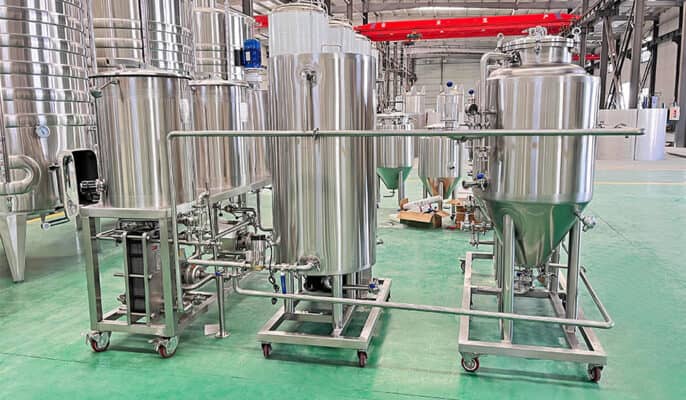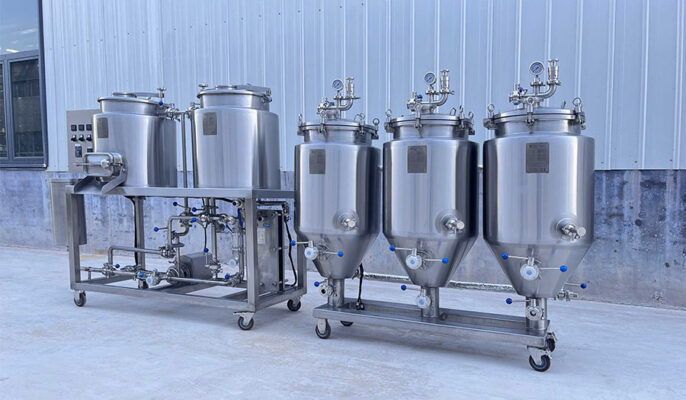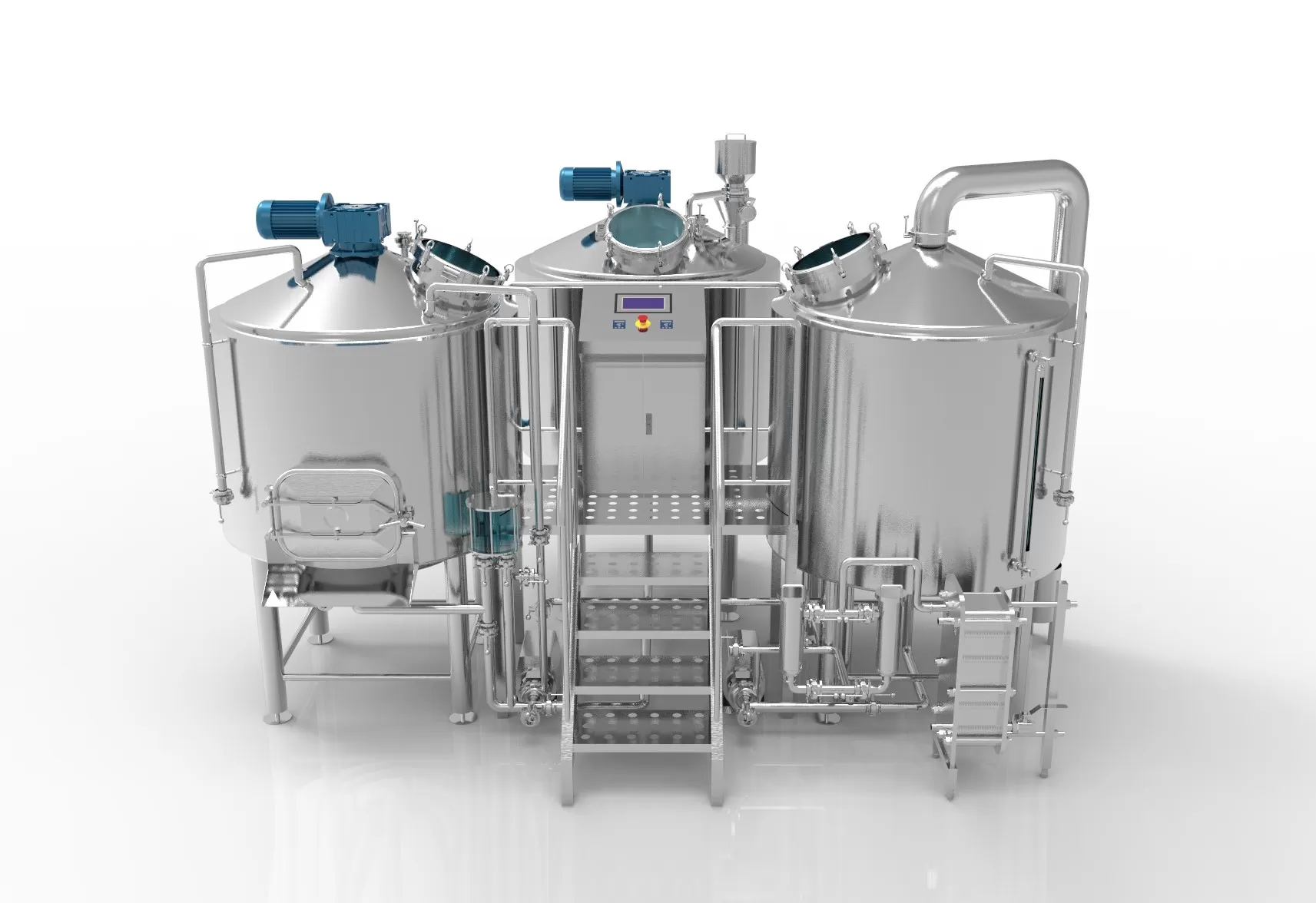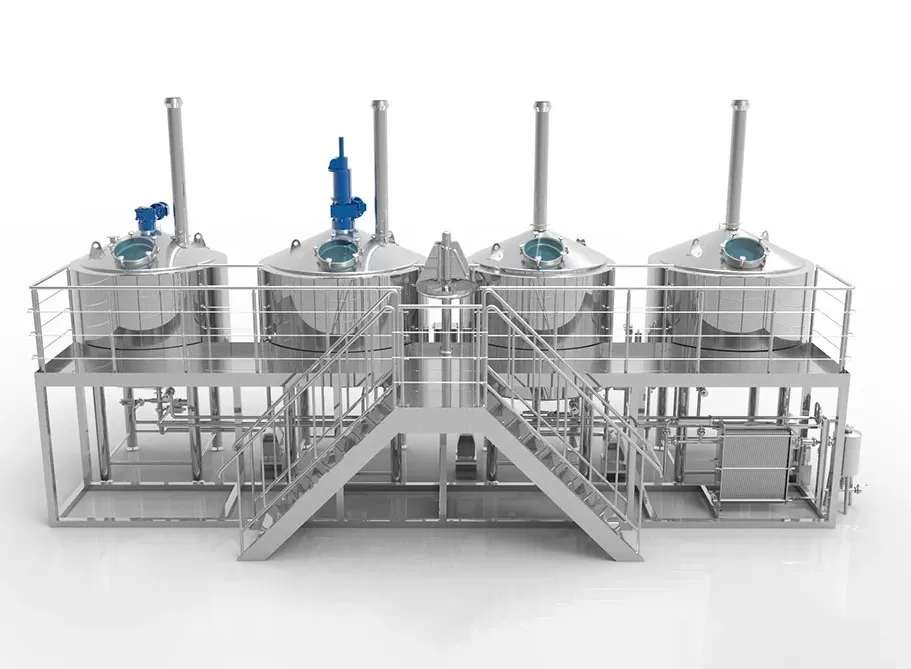La bouilloire est l'un des outils de base les plus importants dans le processus de fabrication de la bière. Que vous soyez un amateur de brassage de bière ou un brasseur professionnel, il est essentiel de comprendre les principes de base du choix d'une cuve de brassage pour produire une bière de haute qualité. Les cuves de brassage en acier inoxydable influencent non seulement la consistance et la saveur de votre bière, mais ont également un impact direct sur l'efficacité et la facilité d'utilisation. Dans ce guide, le groupe Micet vous aidera à choisir la cuve de brassage idéale pour vos besoins. Des différents types et matériaux disponibles aux diverses caractéristiques et tailles à prendre en compte, nous vous fournirons toutes les informations dont vous avez besoin pour prendre une décision éclairée.
Qu'est-ce qu'une bouilloire en acier inoxydable ?
Les cuves de brassage sont de grands récipients utilisés pour faire bouillir les ingrédients et extraire les arômes pendant le processus de brassage. Elles jouent un rôle essentiel dans l'obtention de la saveur, de l'arôme et de la couleur souhaités pour la bière. La précision et le souci du détail sont essentiels lors du brassage de la bière. Les cuves de brassage offrent aux brasseurs le contrôle nécessaire à la fabrication de la bière parfaite. De la désinfection à l'utilisation du houblon, ces cuves sont essentielles à chaque étape du processus de brassage. Les cuves de brassage en acier inoxydable sont idéales pour le brassage de la bière car elles sont durables, résistantes à la corrosion, moins réactives et faciles à nettoyer et à désinfecter. Il s'agit également d'une option relativement peu coûteuse par rapport à d'autres matériaux tels que le cuivre ou l'aluminium, surtout si l'on considère le coût sur l'ensemble de sa durée de vie.

Choix du matériau pour la bouilloire
Il existe de nombreuses bouilloires disponibles sur le marché et lors du choix d'une bouilloire, il est important de bien connaître son matériau, sa fonction, etc.
Bouilloires en aluminium
L'aluminium est un autre matériau couramment utilisé pour fabriquer les bouilloires. Il présente des avantages tels que la légèreté et une meilleure conductivité thermique que l'acier inoxydable. Il est également moins cher. Cependant, il présente également des inconvénients. Par exemple, la couleur des bouilloires en aluminium peut s'estomper ou se décolorer. Il réagit mal à certains produits chimiques et peut endommager la marmite. En fait, dans certains cas, l'aluminium peut se répandre dans le breuvage et se mélanger au produit.
Pour éviter cela, vous pouvez faire bouillir de l'eau dans votre bouilloire avant de l'utiliser. Cela libérera l'oxyde d'aluminium et protégera le métal de l'oxygène. C'est une bonne chose, car l'oxygène est très peu réactif avec l'aluminium. Ce processus permet également d'éviter que l'aluminium ne soit lessivé du moût.
Bouilloire en acier inoxydable
Le processus de brassage nécessite une chaleur et une pression élevées. L'acier inoxydable est un excellent choix car il peut résister à des chauffages fréquents et à des températures élevées sans se déformer ni se corroder, à condition de respecter les consignes d'entretien et de maintenance. L'acier inoxydable résiste beaucoup mieux à la corrosion que l'acier ordinaire, le fer ou l'aluminium. L'acier inoxydable ne réagit pas avec les acides et ne produit ni n'altère en aucune façon les saveurs. Il peut donc être utilisé en toute sécurité, lot après lot, sans affecter l'homogénéité ou compromettre le produit final.
La couche de passivation à la surface de l'acier inoxydable est suffisamment lisse pour faciliter l'assainissement à l'aide de produits chimiques ou de vapeur. Cela permet d'économiser du temps et de l'argent tout en garantissant le maintien de pratiques sanitaires appropriées à tous les stades de la production dans la brasserie.
Bouilloires en cuivre
Le cuivre est un excellent conducteur thermique et peut conduire la chaleur rapidement et uniformément. Au cours du processus de brassage, cette propriété permet de réchauffer et de refroidir rapidement, facilitant ainsi diverses réactions chimiques dans le liquide, en particulier pendant la fermentation de la levure. Il réagit également avec les sulfures pour aider à éliminer les saveurs indésirables et améliorer le goût et la qualité du vin.
L'inconvénient des bouilloires en cuivre est qu'elles sont plus coûteuses que des matériaux tels que l'acier inoxydable. Les bouilloires en cuivre sont plus chères à l'achat et à l'entretien. Le cuivre a tendance à s'oxyder et à former une couche d'oxyde au contact de l'air et de l'eau et doit être nettoyé et entretenu régulièrement pour conserver son état de surface et ses performances.
Différents types de bouilloires de brassage
- Acier inoxydable traditionnel : ces bouilloires sont durables, faciles à nettoyer et peuvent résister à des températures élevées. Elles constituent un choix populaire pour les brasseurs amateurs et les professionnels. Les bouilloires en acier inoxydable présentent un design élégant et intemporel qui n'est pas seulement pratique, mais qui ajoute une touche d'élégance à tout équipement de brassage.
- Système de brassage électrique : Ces bouilloires utilisent l'électricité pour chauffer le liquide, ce qui permet un contrôle précis de la température sans avoir recours à une source de chaleur externe. Les systèmes de brassage électrique ont la faveur des viticulteurs qui privilégient la commodité et la précision. Ces bouilloires sont capables de régler et de maintenir une température spécifique, offrant ainsi un niveau de contrôle inégalé.
- Systèmes de brassage à induction électromagnétique : Les bouilloires à induction électromagnétique utilisent le chauffage électromagnétique pour chauffer rapidement et efficacement. Elles sont réputées pour leur efficacité énergétique et constituent une option respectueuse de l'environnement. Les bouilloires à induction sont particulièrement appréciées des brasseurs professionnels qui doivent chauffer rapidement de grandes quantités de liquide.
- Bouilloires à gaz : ces bouilloires utilisent des brûleurs à gaz ou à propane pour chauffer les liquides. Elles sont souvent préférées par les brasseurs amateurs parce qu'elles sont portables et abordables. Les bouilloires à gaz sont flexibles, ce qui permet aux brasseurs d'emmener leurs aventures de brassage à l'extérieur ou dans d'autres lieux.

L'importance de l'acier inoxydable Bouilloires de brassage dans le domaine de la brasserie
L'ébullition ne se contente pas de chauffer les ingrédients, elle joue un rôle essentiel dans la qualité générale et le caractère de la bière.
- la stérilisation : L'ébullition permet d'éliminer tous les contaminants potentiels et garantit un environnement propre et sûr pour la fermentation de la levure. En traitant les ingrédients à des températures élevées, les micro-organismes nuisibles sont efficacement tués, ce qui réduit le risque d'altération de la bière ou de mauvais goût.
- Activation des enzymes : L'ébullition active les enzymes du malt qui entament le processus de conversion de l'amidon en sucres fermentescibles. Ce processus, connu sous le nom de saccharification, est essentiel pour fournir à la levure les nutriments nécessaires à la production d'alcool et de dioxyde de carbone pendant la fermentation. Sans activation enzymatique adéquate, la bière risque de ne pas avoir la douceur et le moelleux souhaités.
- Utilisation du houblon : L'ébullition permet d'extraire les acides alpha et les huiles essentielles du houblon, qui ajoutent de l'amertume, de la saveur et de l'arôme à la bière. La chaleur de l'ébullition libère ces composés et les fait passer dans le moût. Plus le houblon est bouilli longtemps, plus la saveur amère qu'il apporte est forte. L'équilibre entre l'amertume et la douceur est essentiel pour obtenir une bière ronde et savoureuse.
Comment choisir la bonne bouilloire ?
Choix de la taille
La taille est le premier critère à prendre en compte, car elle influe directement sur le type de bière que vous pouvez brasser et sur sa quantité. Bien sûr, un brasseur débutant peut utiliser une petite casserole de 3 gallons, mais pour brasser la meilleure bière, il faut faire bouillir autant de moût que possible. Les brasseurs maison qui utilisent uniquement des céréales doivent faire bouillir un pot plein dès le départ. Prévoyez l'avenir en achetant une bouilloire dont la capacité est au moins 1,5 fois supérieure à celle de la fournée. Pour un lot de 5 gallons, cela signifie acheter une bouilloire d'au moins 7,5 gallons. L'achat d'une cruche deux fois plus grande vous permettra d'éviter plus efficacement les déversements.
It’s also important to consider the size of your kettle, especially if you have limited space. Some kettles are taller and narrower while others are shorter and wider.
Choix du matériau
Le matériau de votre cuve de brassage joue un rôle important dans le processus de brassage et la saveur de votre bière. Les deux matériaux les plus populaires pour les bouilloires sont l'acier inoxydable et le cuivre. Les bouilloires en acier inoxydable sont connues pour leur durabilité, leur résistance à la corrosion et leur facilité de nettoyage. Elles possèdent également d'excellentes propriétés de rétention de la chaleur qui garantissent une température constante pendant le processus de brassage. Les bouilloires en acier inoxydable sont privilégiées par de nombreux brasseurs pour leur capacité à créer une bière au goût pur.
Fonction de contrôle de la température
Le contrôle de la température est un aspect essentiel du processus de brassage et le fait de disposer des bonnes caractéristiques peut améliorer la qualité de votre bière. L'une des caractéristiques importantes du contrôle de la température à rechercher est un thermomètre intégré. Un thermomètre intégré vous permet de vérifier la température de brassage sans avoir besoin d'outils supplémentaires. Certaines bouilloires sont également équipées d'un système de contrôle de la température intégré, tel qu'un élément chauffant électrique ou un brûleur à gaz réglable. Ces caractéristiques permettent un contrôle précis des températures de brassage pour garantir des résultats optimaux. Les bouilloires dotées d'une base épaisse et isolée sont un autre élément de contrôle de la température à prendre en considération. La base épaisse permet de conserver la chaleur et d'éviter les fluctuations de température qui peuvent affecter le processus de brassage.
Méthodes de chauffage de la bouilloire de brassage
Il existe plusieurs façons d'amener une bouilloire à une ébullition saine. Quelle que soit la faible teneur en substances volatiles des malts modifiés modernes, il est important de porter la bouilloire à ébullition complète afin d'éliminer toutes sortes de substances volatiles indésirables de la bière finale.
Pour obtenir une ébullition à gros bouillons, il faut opter pour un chauffage externe ou direct, par exemple :
- brûleurs à gaz
- Plans de cuisson à induction
- les composants électriques
Considérations budgétaires
Le budget est sans aucun doute un facteur clé pour de nombreux brasseurs lorsqu'ils choisissent une bouilloire pour le brassage de la bière. La gamme de prix des bouilloires peut varier considérablement en fonction de facteurs tels que la taille, les matériaux et les caractéristiques supplémentaires. Les bouilloires en acier inoxydable sont généralement plus abordables que les bouilloires en cuivre, ce qui en fait un choix populaire pour les brasseurs soucieux de leur budget. Les bouilloires en aluminium sont généralement le choix le plus économique, mais elles ne sont pas aussi durables ou ne conduisent pas la chaleur aussi bien que l'acier inoxydable ou le cuivre.
FAQ
Q : Quelle est la fonction principale d'une bouilloire ?
R : Une bouilloire est le principal récipient utilisé pour faire bouillir le moût, le liquide extrait du malt concassé au cours du processus de fabrication de la bière. L'étape de l'ébullition permet de mélanger le moût avec le houblon, de stériliser le mélange et d'améliorer la saveur et l'arôme de la bière.
Q : Quels sont les matériaux utilisés pour les cuves de brassage de la bière ?
R : Les matériaux les plus couramment utilisés pour les cuves de brassage de la bière sont l'acier inoxydable et l'aluminium. Les cuves en acier inoxydable sont appréciées pour leur durabilité, leur résistance à la corrosion et leur impact minimal sur la saveur, tandis que les cuves en aluminium sont généralement moins chères et plus légères, mais sont sujettes aux rayures et aux bosses.
Q : Comment choisir la bonne taille de bouilloire ?
R : Pour déterminer la bonne taille d'une bouilloire, il faut tenir compte de la taille du lot et de la quantité à faire bouillir. Une bonne règle de base consiste à choisir une bouilloire dont la capacité est supérieure d'au moins 25-50% à la quantité prévue. Cela permet d'obtenir une ébullition vigoureuse et d'éviter les débordements.




